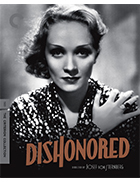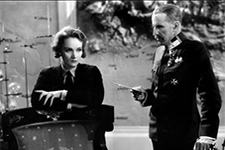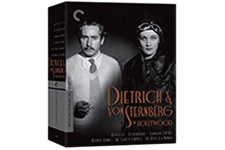| Director: Josef von Sternberg | | Screenplay: Daniel N. Rubin and Josef von Sternberg (story by Josef von Sternberg) | | Stars: Marlene Dietrich (Marie Kolverer / X-27), Victor McLaglen (Colonel Kranau), Gustav von Seyffertitz (Austrian Secret Service Chief), Warner Oland(Colonel von Hindau), Lew Cody (Colonel Kovrin), Barry Norton (Young Lieutenant, Firing Squad) | | MPAA Rating: NR | | Year of Release: 1931 | | Country: U.S. |  |
|  Loosely based on the exploits of the Dutch spy Mata Hari, who was executed by the Germans in World War I, Josef von Sternberg’s Dishonored was primarily an exercise in opportunism, as Paramount rushed it into production to take advantage of the momentum generated by the director’s previous two films starring Marlene Dietrich, the German production The Blue Angel (Der blaue Engel, 1930) and their first Hollywood collaboration Morocco (1930), and to beat MGM’s Greta Garbo vehicle Mata Hari (1931) to theaters. What is so amazing about the film is that it doesn’t look or feel at all like a rush job, as von Sternberg turns what could have been little more than a typical espionage potboiler into another one of his luxuriant visual essays on Dietrich’s smoldering screen presence and his own love of cinematic texture, depth, and tactility. Dietrich’s character, Marie, an Austrian prostitute, is rechristened X-27 after she is recruited in the film’s rainy opening sequence by the comically gruff Austrian Secret Service Chief (Gustav von Seyffertitz). He overhears her boasting quite naturally to another man that she does not fear death, and he confirms her commitment to her country when he pretends to be an enemy spy recruiting her to work against Austria (she even turns down compensation for her work, saying she will do it for her love of country). After that, she is given two assignments, both of which revolve around her having to entice and/or seduce a man who is dangerous to Austria: Colonel von Hindau (Warner Oland), a traitorous Austrian who has been leaking government secrets, and Captain Kranau (Victor McLaglen), a Russian intelligence officer. While these assignments play right into Dietrich’s highly sexualized screen persona, von Sternberg also uses them as a means of humorously subverting expectations, especially in a lengthy sequence in which Marie pretends to be a simple-minded chambermaid in order to seduce a Russian officer named Colonel Kovrin (Lew Cody). Dietrich, who is virtually unrecognizable without her trademark makeup and playing like a silly schoolgirl, demonstrates a flair for comedy that was largely absent from her earlier roles.Von Sternberg, who concocted the story, co-wrote the screenplay with Daniel N. Rubin, a playwright and sometimes screenwriter who had previously helped adapt an O. Henry story for the Gary Cooper western The Texan (1930) and also wrote the lost Walter Lang melodrama Woman Go on Forever (1931). The storyline is fairly basic in its intrigue, although it has some nice touches, such as Marie attempting to smuggle out information by writing it as musical notation. There are also some wonderfully memorable lines of dialogue, such as von Hindau’s defeated admonition, “What a charming evening we might have had, if you had not been a spy … and I a traitor.” Like many of von Sternberg’s films, the narrative often takes a backseat to his love of visual opulence and Dietrich’s image; the cinematography was by Lee Garmes, in the second of his five collaborations with von Sternberg, and the uncredited production design was by the prolific German émigré Hans Dreier, who was nominated for an Oscar for his work on Morocco the year before, the second of his eventual 20 nominations; he went on to win three Oscars, two of which he won in the same year for Sunset Blvd. (1950) and Samson and Delilah (1949), back when the Academy gave separate awards for work in black and white and color. That opulence is never so evident as in the film’s extravagant Viennese masked ball sequence, which finds Marie trying to seduce both Colonel Kranau and Colonel von Hindau from behind an exotic mask in a frame that is literally choking on streamers and constant movement. It is a preeminent example of von Sternberg’s ability to generate a fantastical milieu that somehow still feels strangely within the bounds of reality. | Dishonored Criterion Collection Blu-ray |  Dishonored is available exclusively as part of the Criterion Collection’s “Dietrich & Von Sternberg in Hollywood” boxset, which also includes Morocco (1930), Shanghai Express (1932), Blonde Venus (1932), The Scarlet Empress (1934), and The Devil Is a Woman (1935). Dishonored is available exclusively as part of the Criterion Collection’s “Dietrich & Von Sternberg in Hollywood” boxset, which also includes Morocco (1930), Shanghai Express (1932), Blonde Venus (1932), The Scarlet Empress (1934), and The Devil Is a Woman (1935). | | Aspect Ratio | 1.19:1 | | Audio | English Linear PCM 1.0 monaural | | Subtitles | English | | Supplements | New interviews with film scholars Janet Bergstrom and Homay King; director Josef von Sternberg’s son, Nicholas; Deutsche Kinemathek curator Silke Ronneburg; and costume designer and historian Deborah Nadoolman LandisNew documentary about actor Marlene Dietrich’s German origins, featuring film scholars Gerd Gemünden and Noah IsenbergNew documentary on Dietrich’s status as a feminist icon, featuring film scholars Mary Desjardins, Amy Lawrence, and Patricia WhiteThe Legionnaire and the Lady, a 1936 Lux Radio Theatre adaptation of Morocco, featuring Dietrich and actor Clark GableNew video essay by critics Cristina Álvarez López and Adrian MartinThe Fashion Side of Hollywood, a 1935 publicity short featuring Dietrich and costume designer Travis BantonTelevision interview with Dietrich from 1971Insert book featuring essays by critics Imogen Sara Smith, Gary Giddins, and Farran Smith Nehme | | Distributor | The Criterion Collection | | SRP | $124.95 | | Release Date | July 3, 2018 | | | COMMENTS | | Calling Criterion’s Dietrich & Von Sternberg in Hollywood a major release doesn’t quite do it justice, as the set pulls together six major films that represent the near entirety of one of the most important, fascinating, and influential director-actor collaborations in film history. Not only does the Criterion boxset include all six of the films Marlene Dietrich and Josef von Sternberg made together during their years working for Paramount (the only exclusion is 1930’s The Blue Angel, which was a German production distributed in the U.S. by Paramount), but there is a host of extras that contextualize the films historically and aesthetically and help us better appreciate the artistry of Dietrich and von Sternberg. In terms of sound and image, all six films are in the best condition they’ve ever been in on home video. Given that all of the films were made between 1930 and 1935, they certainly reflect the style and quality of filmstock, cameras, and sound recording technologies at that time, which is how it should be. Morocco and Dishonored, both of which were early synchronized sound films, are both presented in their proper 1.19:1 aspect ratio, which reflects the compromise made at the time to use the silent-era parameters of 35mm film stock and take away from of the image to make room for the optical soundtrack. The other four films are presented in their 1.33:1 or 1.37:1 Academy aspect ratio. Morocco was transferred in 2K from a 35mm safety fine-grain held by the UCLA Film & Television Archive; Dishonored, Blonde Venus, and The Scarlet Empress were all transferred in 4K from 35mm nitrate prints held by the UCLA Film & Television Archive; Shanghai Express was transferred in 4K from a 35mm duplicate negative and a composite fine-grain print by Universal Pictures; and The Devil Is a Woman was also transferred in 4K from a 35mm safety duplicate negative. Extensive digital restoration was performed on all six films, leaving them as clean and blemish-free as one could possibly expect. The image quality of the films gradually improves with each one, not necessarily because of the transfers, but because of the improvements in film stock and the slightly increased resolution of the later sound films. Morocco definitely looks the softest and the grainiest, while the later films have a much sharper appearance, with stronger contrast and finer detail, albeit with plenty of film grain still present. Criterion had previously released The Scarlet Empress on DVD, and the comparison between that transfer and the new one is substantial, with the new high-definition presentation bearing remarkably better depth and detail and with none of the visible wear and tear of the earlier transfer. Like the image quality, the sound quality of each film is very good, although representative of the technological limitations of the time. The monaural soundtrack for Morocco was mastered from a 35mm safety fine-grain; Dishonored, Blonde Venus, and The Scarlet Empress’s soundtracks were mastered from their respective 35mm nitrate prints, while The Devil Is a Woman track was mastered from a 35mm soundtrack positive. And, finally, Shanghai Express’s soundtrack was mastered and restored by Universal from a 35mm optical soundtrack negative. The supplements, which together comprise hours of material, are scattered across the six discs. The Morocco disc features “Weimar on the Pacific” (30 min.), a detailed featurette about Dietrich’s German origins that features interviews with film scholars Gerd Gemünden and Noah Isenberg; “Crazy Love,” a 31-minute interview with film scholar Janet Bergstrom about Morocco’s production and reception; “The Real Amy Jolly” (20 min.), an interview with Deutsche Kinemathek curator Silke Ronneburg (who shows up in another featurette on the Blonde Venus disc) about the real-life woman on whom the Dietrich character is based; and “The Legionnaire and the Lady,” a 60-minute Lux Radio Theatre adaptation of Morocco from 1936 that features Dietrich reprising her role and Clark Gable standing in for Gary Cooper. The Dishonored disc includes “Bodies and Spaces, Fabric and Light” (30 min.), an absolutely fascinating video essay by film scholars Cristina Alvarez Lopez and Adrian Martin about von Sternberg’s unique visual style; “Dietrich Icon” (20 min.), a featurette in which film scholars Mary Desjardine, Amy Lawrence, and Patricia White discuss how Dietrich became a complex and subversive Hollywood icon in her collaboration with von Sternberg; and a video interview with von Sternberg’s son, Nicholas, from 2014. The Shanghai Express disc includes only one supplement, but it is a great one: a 23-minute interview with film scholar Homay King, author of Lost in Translation: Orientalism, Cinema, and the Enigmatic Signifier, about the film’s complicated and, in some regards, regressive depiction of the “exotic” East. The Blonde Venus disc includes “The Fashion Side of Hollywood” (10 min.), a publicity short from 1935 that features Dietrich modeling clothes designed for her by costume designer Travis Banton, and “The Marlene Dietrich Collection” (15 min.), a 15-minute featurette about the immense collection of Dietrich memorabilia housed at the Deutsche Kinemathek in Berlin, featuring an interview with curator Silke Ronneburg. The Scarlet Empress and The Devil Is a Woman discs also have only one supplement each: On the former, we have “Marlene Dietrich in Denmark” (29 min.), a retrospective interview with Dietrich from 1971 that aired on Swedish television, while on the latter we have the audio from a 78 rpm promotional disc of the song “If It Isn’t Pain,” which had to be cut from the film due to restrictions by the Production Code Administration (PCA). Finally, the boxset is packaged with a thick insert book that features essays on each film by critics Imogen Sara Smith, Gary Giddins, and Farran Smith Nehme. |
Copyright © 2018 James Kendrick Thoughts? E-mail James Kendrick All images copyright © The Criterion Collection |



 (3)
(3)

 Dishonored is available exclusively as part of the Criterion Collection’s “Dietrich & Von Sternberg in Hollywood” boxset, which also includes Morocco (1930), Shanghai Express (1932), Blonde Venus (1932), The Scarlet Empress (1934), and The Devil Is a Woman (1935).
Dishonored is available exclusively as part of the Criterion Collection’s “Dietrich & Von Sternberg in Hollywood” boxset, which also includes Morocco (1930), Shanghai Express (1932), Blonde Venus (1932), The Scarlet Empress (1934), and The Devil Is a Woman (1935).